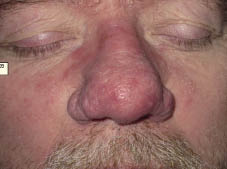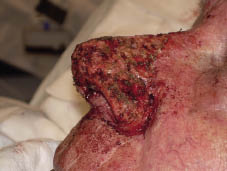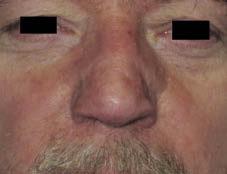Ole Martin Rørdam and Kjetil K. S. Guldbakke
Department of Dermatology, St Olav’s Hospital, Olav Kyrres Gate 17, NO-7006 Trondheim, Norway. E-mail: kjetil.guldbakke@stolav.no
Accepted June 11, 2010.
Ole Martin Rørdam and Kjetil K. S. Guldbakke
Department of Dermatology, St Olav’s Hospital, Olav Kyrres Gate 17, NO-7006 Trondheim, Norway. E-mail: kjetil.guldbakke@stolav.no
Accepted June 11, 2010.
Several surgical procedures have been described for patients with rhinophyma. Rhinophyma affects a small proportion of patients with phymatous rosacea. The word rhinophyma originates from the Greek word “rhis” for nose and “phyma” for growth. The condition is characterized by slow progressive hypertrophy of the sebaceous glands and connective tissue on the distal nose. Other common cutaneous findings include erythema, telangiectasia and a widened pore diameter. Tumour-like nodules, with risk of nasal obstruction and sleep apnoea, may occur in the advanced stages. Rhinophyma may be localized or generalized on the nose, but typically affects the lower two-thirds. Men between the ages of 45–60 years are at highest risk. Several aetiological theories have been hypothesized, but the pathogenesis is unknown (1, 2). Rhinophyma may lead to social stigmatization, as illustrated by common synonyms, such as “potato” and “whiskey” nose. We describe here our experience using electrosurgery with a wire loop to treat rhinophyma.
METHODS
Three male patients, aged 62, 79 and 86 years, were recruited from August 2008 to October 2009. They all had moderate to large rhinophyma (Fig. 1). Previous empirical therapy included topical antibiotics, steroids and retinoids, as well as systemic antibiotics, cryotherapy and pulsed dye laser had been without effect. Surgery was performed at our outpatient department. The surgical procedure was as follows:
The whole procedure required approximately 30–45 min. All patients were instructed to use chloramphenicol ointment twice daily for 10–14 days postoperatively. Photographs were taken before, during and after surgery as an objective measure of cosmetic result.

Fig. 1. Patient 1, preoperatively.

Fig. 2. Bleeding spot postoperatively.
RESULTS
Patients were followed with regular outpatient controls for 3 months after surgery. Cutaneous re-epithelialization was noted 14 days postoperatively in all three cases. Residual erythema lasted 4–8 weeks. No significant pain was reported in the postoperative period. None of the patients developed wound infection, scarring or pigmentary disturbances. The cosmetic result assessed by the patient and surgeon was evaluated as very good in all cases (Fig. 3).

Fig. 3. Patient 1, 6 weeks postoperatively.
DISCUSSION
Rhinophyma often goes untreated and may lead to social stigma. Medical therapy generally has disappointing results, except for in the very early stages of phymatous change. Topical metronidazole and systemic antibiotics are alternatives for patients with clinical signs of active inflammation. Topical tretinoin can also be used with some effect. A few case reports of success with isotretinoin have been published. No medical therapy to date has been shown to induce regression or prevent the development of rhinophyma (2).
Surgery is considered to be the gold standard of lower limbtherapy for moderate-to-large rhinophyma. Surgery aims to remove the hypertrophied sebaceous glands, with subsequent normalization of nasal contour. A wide range of surgical and laser techniques have been described in the literature, including: (i) total excision with skin transplantation or flapping of the defect (3); (ii) partial excision healing by secondary intention (4); (iii) CO2 laser ablation (5); (iv) cryosurgery (6); and (v) electrosurgery (7). There is no consensus on which therapeutic modality is preferable. Potential complications with all surgical techniques include scarring, “honeycombing”, asymmetry and perforation of the nasal cartilage.
Therapeutic options for patients with rhinophyma are limited and of variable quality. Several surgical techniques have been described, all with advantages and disadvantages. We describe here our experience using electrosurgery in three patients with moderate-to-large rhinophyma. The greatest advantage of electrosurgery is good haemostasis, which is a common problem with standard surgical techniques.
In conclusion, electrosurgery using a wire loop is a fast, low-cost and relatively pain-free surgical procedure with good haemostasis. In our experience the operation has few complications, rapid healing time and gives a good cosmetic result. We consider electrosurgery a good alternative in a laser era.
REFERENCES
